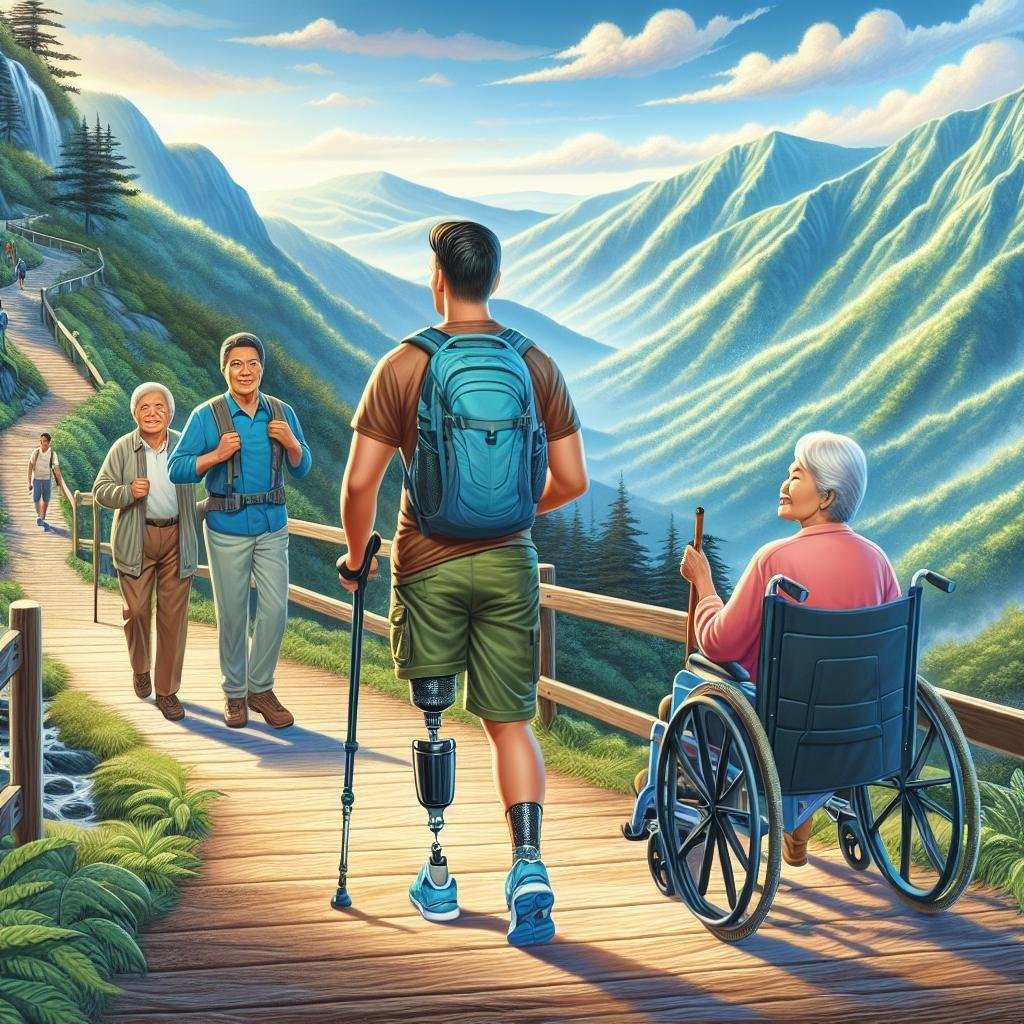Nestled between the lush ridges and misty valleys of the Smoky Mountains lies a treasure trove of natural beauty, inviting explorers from far and wide to traverse its enchanting trails. Yet, this awe-inspiring expanse is not just a haven for the able-bodied hiker; it is indeed a sanctuary that extends its breathtaking vistas and serene pathways to adventurers of all abilities. In an era where inclusivity and accessibility are more than mere buzzwords, the Smoky Mountains stand as a testament to nature’s universal embrace. This article embarks on a journey through forests and streams,revealing the trails that have been thoughtfully crafted for those with disabilities,ensuring that everyone can experience the majesty and tranquility of this iconic landscape. Join us as we explore the accessibility advancements, community efforts, and personal stories, shedding light on how the Smoky Mountains have been made accessible to all who seek solace and wonder in the great outdoors.
navigating Nature’s Beauty: Accessible Paths in the Smoky Mountains
The Great Smoky Mountains National Park offers a stunning tapestry of natural beauty, creating a picturesque backdrop for adventurers of all abilities. For those with disabilities, exploring these majestic landscapes is made more accessible thanks to a range of well-designed trails. The Laurel falls Trail stands out as a favored choice, boasting a paved path that stretches for 2.6 miles round-trip, leading to a captivating 80-foot waterfall. This trail not onyl ensures a smooth journey but also offers interactive exhibits and resting spots, making it easier for everyone to fully immerse in the tranquility of the surroundings.
Several other paths have been tailored to accommodate diverse mobility needs. Among them,the Sugarlands Valley Accessible Trail provides a 0.5-mile loop that meanders through lush forests and alongside serene streams. Key features of this trail include wide paths, gentle gradients, and plenty of benches for relaxation. For those planning a visit, here’s a quick look at what some accessible trails offer:
| Trail Name | Distance | Features |
|---|---|---|
| Laurel Falls | 2.6 miles | Paved path, Waterfall |
| Sugarlands Valley | 0.5 miles | Wide paths, Streams |
Trail Tips: Preparing for a Disability-friendly Hiking Experience
Embarking on a hiking adventure requires careful planning, especially when accommodating specific needs to create an inclusive experience. Begin by focusing on essential gear that can greatly enhance accessibility. Consider using specialized equipment like all-terrain wheelchairs or trail-ready walkers. Adaptive devices,such as walking poles with grips,can offer additional support and stability,making the lovely trails more navigable. Moreover, ensure that your backpack is lightweight and includes essentials such as water bottles with easy-pour spouts and snacks in easy-to-open packages.
Readiness is not only about having the right gear but also about choosing trails that best suit your needs.Use resources from the national Park Service or local trail associations that offer insights into accessible trails within the Smoky Mountains. When planning your route, check for amenities like restrooms and seating areas along the trail, which can greatly enhance your experience. Consider the table below for a quick overview of some accessible trails:
| Trail Name | Difficulty Level | Amenities |
|---|---|---|
| Laurel Falls Trail | Moderate | Restrooms, Benches |
| Cades Cove Loop | Easy | Parking, Picnic Areas |
| cataract Falls Trail | Easy | Data Panels, Shaded Areas |

Inclusive Adventure: Gear and Resources for Hikers with Disabilities
Exploring the lush landscapes of the Smoky Mountains is no longer a confined dream for outdoor enthusiasts with disabilities. Thanks to innovative gear and targeted resources, the trails are opening up to a broader audience. Accessible hiking gear has become more advanced, with options like all-terrain wheelchairs, lightweight trekking poles designed for enhanced grip, and adaptive handcycles. For those with sensory impairments, consider investing in tactile maps and GPS devices with voice-guided navigation. These innovations ensure that everyone can embrace the breathtaking vistas without physical limitations holding them back.
The community dedicated to inclusivity has been hard at work identifying accessible trails and compiling useful resources. Many trails, such as those around the Sugarlands Visitor Center, have been rated based on their accessibility features. Here’s a quick glimpse of some accessible hiking spots in the smoky mountains:
- Cades Cove Loop road: Offers stunning scenery and ample spots to pause and take in the view.
- Laurel Falls Trail: A popular paved pathway leading to a picturesque waterfall.
- Clingmans Dome Observation Tower: A wheelchair-accessible ramp leads to sweeping mountain vistas.
Take advantage of online communities and forums dedicated to disabled hikers, where you can find firsthand accounts and reviews. additionally, rangers at the Smoky Mountains National Park have ongoing initiatives to improve accessibility, and they are always willing to offer guidance and support.
| Trail Name | Difficulty | Accessibility Features |
|---|---|---|
| Gatlinburg Trail | Easy | Wide paths, flat terrain |
| Cataract Falls | Easy | Accessible trailhead, rest areas |

Breathtaking Views for Everyone: Scenic Spots with Easy Access
Exploring the wondrous landscapes of the Smoky Mountains doesn’t have to be an arduous task. Accessible trails and scenic spots are designed to ensure that everyone can enjoy nature’s unparalleled beauty regardless of physical abilities. Taking a stroll along the paved Gregory ridge Trail, for instance, allows visitors to immerse themselves in lush forests and witness captivating vistas without the stress of arduous terrain. Furthermore, various other trails, such as the Oconaluftee River Trail, blend gentle, even pathways with vibrant river views — perfect for wheelchair users and families with strollers. These trails are marked by their wide paths, durable surfaces, and access to benches where one can pause and absorb the breathtaking surroundings.
In an effort to enhance accessibility, many visitor centers in the smoky Mountains provide loaner equipment and guides geared towards inclusive exploration. The Sugarlands Visitor Center, such as, offers valuable resources and maps detailing routes with minimal elevation changes. Discover indulgent sights such as the glittering cascades and diverse flora with ease, guided by brochures that cater specifically to sensory-deprived visitors, offering Braille editions and audio descriptions. For those concerned about restroom availability, most accessible trails are equipped with facilities at the start or along the way. here’s a quick glance at available amenities:
| trail Name | Wheelchair Access | Restroom Facilities |
|---|---|---|
| Oconaluftee River Trail | Yes | Available |
| Paved Gregory Ridge Trail | Yes | At trailhead |
| Fighting Creek Nature Trail | Moderate | Available |
Q&A
Q&A: Accessing Hiking Trails with Disabilities in the Smoky Mountains
Q1: Are there accessible hiking trails for individuals with disabilities in the Smoky mountains?
A1: Absolutely. The smoky Mountains offer several trails designed with accessibility in mind. These trails are meant to provide a safe and enjoyable experience for all visitors,regardless of physical ability. For instance, the Sugarlands Valley Nature Trail and the Cades Cove Loop Road are well-maintained and wheelchair-friendly, offering stunning views of the natural landscape.
Q2: What features make these trails accessible?
A2: Accessible trails in the Smoky mountains typically have smooth, hard-packed surfaces suitable for wheelchairs and mobility aids. These trails often have moderate grades, with benches and rest areas spaced along the way to offer visitors a chance to rest. Information panels and signage are generally placed at accessible heights and are designed with large,easy-to-read fonts.
Q3: Are there any facilities available for people with disabilities at trailheads?
A3: Yes, many of the trailheads leading to accessible trails come equipped with facilities catered to individuals with disabilities. These include accessible parking spaces, restrooms with adequate access, and sometimes even tactile maps or guides to enhance the overall hiking experience.
Q4: How can a person with disabilities prepare for a hike in the smoky Mountains?
A4: Preparation is key. Visitors with disabilities should check ahead for trail conditions and accessibility updates from the official Great Smoky Mountains National Park website.Bringing along a companion could be beneficial for support, and packing essential items such as water, snacks, a first-aid kit, and any required personal medical equipment is advised. Additionally, checking the weather forecast is vital to ensure safe hiking conditions.
Q5: Are guided tours available for people with disabilities in the Smoky Mountains?
A5: Yes, guided tours are available and can be a splendid way to explore the Smoky Mountains. These tours are frequently enough led by educated guides who can tailor the experience to suit varying needs and abilities, providing insights into the local ecology and history while ensuring accessibility and safety throughout the adventure.
Q6: What should trail managers consider to improve accessibility further?
A6: Improving accessibility requires ongoing evaluation and adaptation. Trail managers should consider investing in further infrastructure upgrades, such as wider paths, more tactile guide rails, and comprehensive trail information systems. Additionally,organizing feedback forums with the disabled community can offer valuable insights into user experiences and highlight areas needing improvement.
Q7: Are there any special events or programs in the Smoky Mountains that focus on accessibility?
A7: Occasionally, the Smoky Mountains host events and educational programs that emphasize inclusivity and accessibility. These may include accessible group hikes, nature workshops, and wildlife observation events tailored to cater to participants with disabilities. Keep an eye on the park’s event calendar for upcoming opportunities.
By focusing on enhancing accessibility, the Smoky Mountains endeavor to welcome all adventurers, ensuring everyone can experience the serene and magnificent beauty these trails have to offer.
The Way Forward
As the sun sets behind the majestic peaks of the Smoky Mountains, draping the landscape in hues of gold and lavender, the promise of inclusion dances in the cool mountain air. The journey to make hiking trails more accessible to everyone is one of shared commitment and hope, weaving together stories of determination and joy. By removing barriers, both physical and metaphorical, the natural beauty of these trails opens its arms wider, welcoming those who have longed to immerse themselves in the serenity of these ancient woods.
Every footprint left along these trails tells a tale of resilience and discovery,reminding us of the profound connection we all share with the Earth. The path toward accessibility is ever-evolving, inviting collaboration among park officials, advocates, and the community to ensure that the wonders of the Smoky Mountains are not just seen, but truly experienced by all. As we step forward, may we nurture not only the land but also the spirit of inclusivity, ensuring that the beauty and tranquility of these trails speak to every heart, inviting each one of us to find our own place among the whispers of the trees and the songs of the streams.

